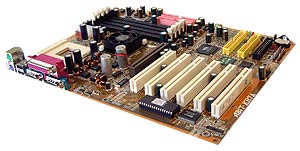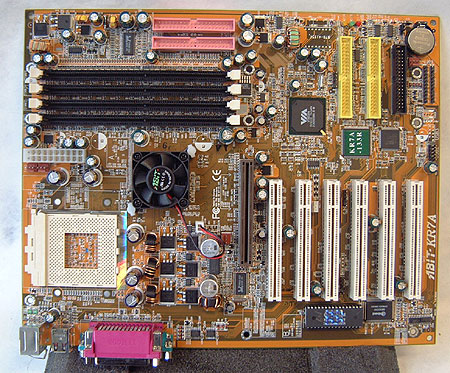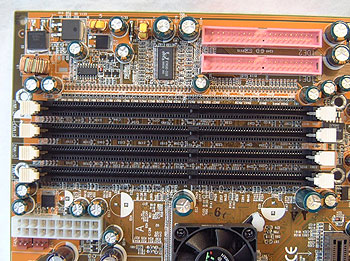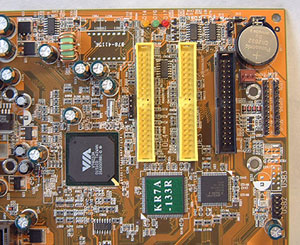Abit KR7A-133RAID Socket A Motherboard Review
 Abit has
always had a warm spot in the hearts of overclockers because they openly embrace the enthusiast market, which can sometimes be a
dangerous path to walk. While Abit has never openly endorsed overclocking, they have made attempts to please the performance user in this regard. The first such example is of course the ability to change FSB in 1 MHz increments.
Abit has
always had a warm spot in the hearts of overclockers because they openly embrace the enthusiast market, which can sometimes be a
dangerous path to walk. While Abit has never openly endorsed overclocking, they have made attempts to please the performance user in this regard. The first such example is of course the ability to change FSB in 1 MHz increments.
In
general Abit have opened up a lot of features in the BIOS which allow the user take full control of the system, and in recent times Abit have even coined their own "Abit Engineering" ideology. With such milestones as onboard IDE/RAID controllers and overclocking stripes it's little wonder.
In typical Abit fashion, the KR7A-133RAID is a little bit more expensive then the curve. Weighing in at $250 CDN it's probably one of the most expensive VIA KT266A boards around. Knowing that the KR7A-133R has a KT266A chipset just about guarantees it will be a good performer, but
how does Abit separate itself from the rest?
With a 4x AGP 2.0 slot, six 32 bit PCI's, VIA's 8233A Ultra/133 southbridge, onboard IDE Ultra/133 RAID and four DIMM slots there isn't much more you can ask for. USB 2.0 is gaining a lot of momentum and with most high-end manufacturers including it with their boards, perhaps Abit should also
consider adding it in the near future as well.
| abit
kr7a-133raid |
 |
Ships with the following:
- 2x IDE ATA66/100 Cable
- FDD Cable
- Driver CD
- User Manual
- Quick Start Guide
- Blue cable clips
 |
We really
pleased with the overall layout of the KR7A-133RAID - everything is well placed
and
easy to get to. A prime example of that is the location of the ATX
power connector, at the top of the board and next to the DIMM slots. The
placement ensures that the power cable doesn't interfere with the case air flow
and still keeps the trace lines to the onboard powersupply
short.
The
KR7A-133RAID has three onboard LED's. The orange one lets
users know whether if the board has power or not, the green one shows if the
board is powered on and the red one shows when the reset switch is pressed. This is
quite useful when diagnosing a motherboard problem as it's not always in
a case so you can't see what is happening. If I had the chance to make a
wish list of features I think it would be good to go one step further and show
if there is HDD activity as well.

The KR7A-133RAID has a total of four fan
headers and unlike most other manufacturers, all are easily accessible, with three
remaining after the processor cooler has been plugged in. With its six PCI slots, you're guaranteed that you won't
have any problems with expansion in the future should you need to install new
devices, and you are also guaranteed that the DIMM slots will interfere with AGP card. It's a fact of life
with boards like this that you need to remove the video card to add
memory.

The KR7A also
comes with onboard IDE RAID using HighPoint's HPT 372 chipset which has
support for Ultra/133 and RAID's 0, 1 and 0+1. The only difference
between the original KR7A and KR7A-133 is that the KR7A-133 uses VIA's new
VT8233A southbridge which supports Ultra/133 based hard
drives.
The AGP port on the KR7A-133RAID is within
AGP 2.0 spec's so owners of GeForce4 Ti series of cards shouldn't have to
worry.
Should you be too eager on your overclocking adventures, it's nice to
know that the Clear CMOS jumper is easily accessible at the lower right hand
corner of the board (something you will appreciate when the board is installed in
case).

As with everything in life, the
Abit KR7A-133RAID isn't completely perfect even though we
really do like it a lot. With the IDE RAID controller connectors
near the bottom of the board, you can only expect to use full
length PCI cards in the first three PCI slots. If you did
manage to install full length cards in the lower PCI slots,
the IDE and floppy drive cables would have to wrap around the devices. This isn't the best solution
since it usually means airflow is disrupted.

The
floppy drive connector is in one of the worst places for users of large sized
cases like the Aopen HX08. Placed near the bottom of the board it may
not be long enough to reach lofty FDD positions. At least the accompanying black
FDD ribbon cable was long. While it's not really a big deal, I was a bit
disappointed that the KR7A-133RAID
only came with four USB 1.1 ports, and that the USB header bracket
wasn't included. The original KR7A has six USB 1.1 ports and comes with
all the appropriate cables (I know because my main rig at home uses the
KR7A-RAID).

